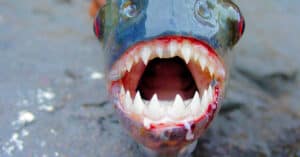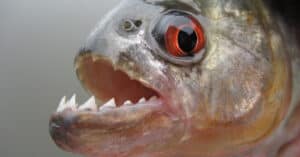Piranhas are one of the several sea creatures that come in many shapes and sizes. Given that they are fascinating creatures that have effortlessly captured viewers’ hearts, they have been depicted over time in adventure movies as voracious predators in amazon rivers. Despite their voracious nature, some individuals still keep piranhas as aquarium specimens up till this present time.
Are piranhas as dangerous as they are depicted in many movies today? Let us look into these sea creatures as this article covers every facet and interesting facts you should know about piranhas.
Background on Piranhas
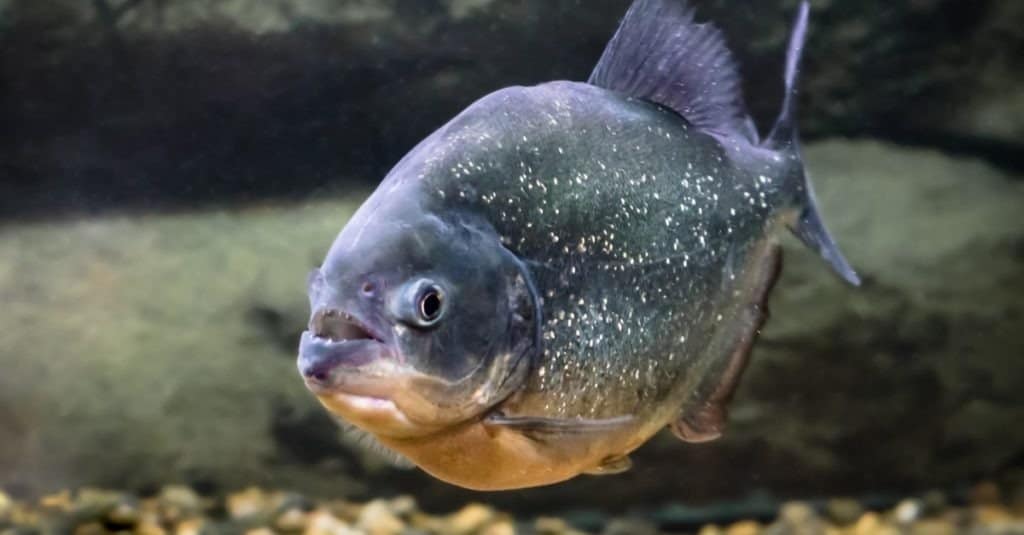
Native to South America, piranhas dwell in shoals and possess sharp teeth.
©ChocoPie/Shutterstock.com
Piranhas are deep freshwater species of fish native to South America that dwell in shoals and possess razor-sharp teeth for tearing their prey apart. These omnivorous fish have a reputation for being dangerous predators. Moreover, between 30 to 60 different species are thought to exist, but the actual quantity is uncertain, debatable, and unproven scientifically. There are around 20 diverse species in the Amazon River itself, with an actual length between 6 to 8 inches; however, these have been documented as long as 20 inches.
The well-known red-bellied piranha has a silvery body with red patches. Nevertheless, other piranhas come in yellow, greenish, and black colors. In the murky waters where these fish reside, this acts as a type of camouflage. In the Amazonian indigenous dialect, piranhas mean ‘toothfish.’
Are Piranhas Dangerous?
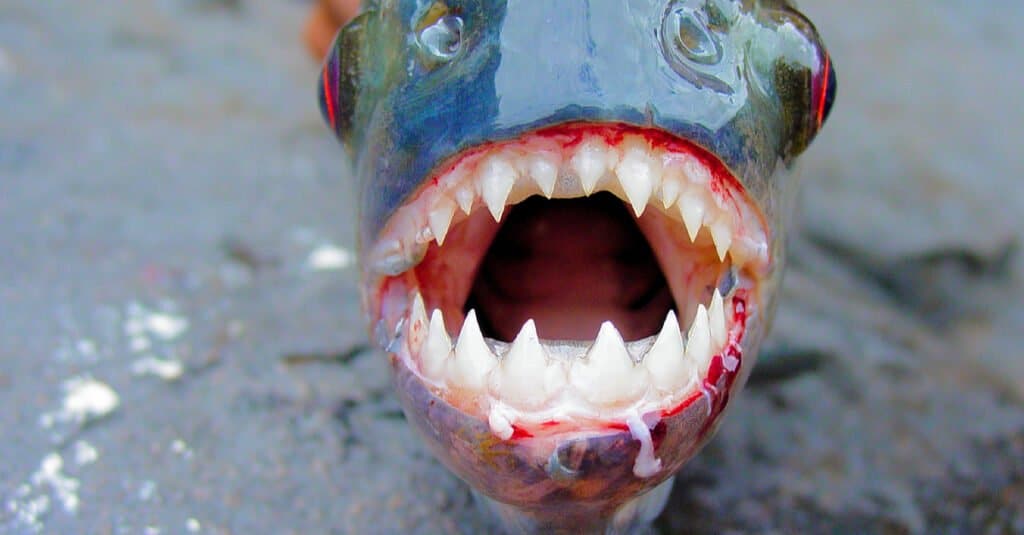
Although piranhas are aggressive, they rarely attack humans.
©The Jungle Explorer/Shutterstock.com
Piranhas are more often scavengers than hunters. These sea omnivores prefer dead flesh to live creatures, and surprisingly, they are not as dangerous as they are made up to be in movies. Intriguingly, piranhas bark or grunt when they feel defensive and are afraid of humans like other small fish. Although these sea creatures rarely attack humans, they become more aggressive and bite when food is scarce, and waters are low in dry seasons. Unfortunately, many incidents of piranha attacks in the media happened when humans disrupted their nests or provoked them with water splashes.
What Sea Animals Prey on Piranhas?
Humans, Amazon river dolphins, crocodiles, herons, storks, turtles, egrets, and caimans are natural predators of piranhas. However, to avoid being on the menu for wild water predators, these sea vertebrates travel on shoals and keep a safe distance from these larger sea animals. They are natural scavengers who only get ‘frenzied’ when dead flesh is in the water. Piranhas, a dietary staple for Amazonian indigenous peoples, are more likely to be consumed by humans rather than the other way round.
What Do Piranhas Eat?
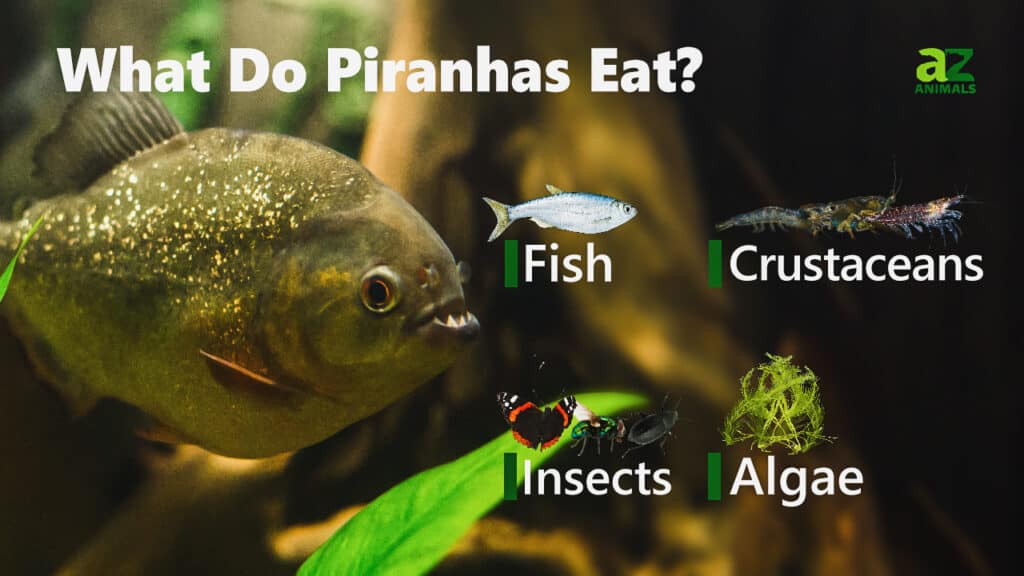
You might be wondering what these sea creatures ingest as food and why their teeth are so sharp if they are not as dangerous as we claim. Well, the answers to your thoughts are crystal clear as these marine vertebrates generally use their teeth as a defense mechanism against predators and scavenge for their daily bread. Most piranhas are carnivores, but some species sustain themselves solely on morsels nipped from the fins and scales of other fishes.
Some species of the hyperactive piranhas may also attack sizable live animals, which, in most cases, is uncommon. But it is interesting to note that smaller fishes, crabs, other sea creatures, plants, seeds, and fruit make up most of the piranha’s diet.
Are Piranhas a Threat to Humans?
Undoubtedly, piranhas are as frightening to the local population as a swarm of crows is frightening to a larger percentage of humans. However, for emphasis again, piranhas are not as terrifying as they have been made to appear over the years. But unfortunately, because of their razor-sharp teeth, many news outlets have exaggerated their threatening tendencies toward the common man.
Are Piranhas Legal to Harvest?
Even though piranhas do not pose a threat to humans, they effortlessly are a menace to native fish varieties. As a result of this intimidating remark, many nations prohibit the importation of piranhas, their breeding, and even their retention in aquariums.
Intriguingly, these marine vertebrates are native to the South American States, where they reside in tropical rivers, streams, and murky water.
Which Piranha is the Most Dangerous?
The red-bellied piranha (Pygocentrus nattereri) is not native to the United States. However, they are among the most well-known dangerous piranhas found in the Amazon, Argentina, Peru, Columbia, Paraguay, paraná, and Essequibo basins. Surprisingly, they also inhabit the coastal rivers of northeastern Brazil. These particular species of piranhas are not migratory but often seek a conducive breeding environment during rainfalls. They have a red underbelly that extends from the chins and cheek to the tummy with their laterally compressed bodies, long dorsal fins, and differing heads dimensions unique to them. The head and torso are gray, with dazzling silver scales on the sides. They particularly bite one another in the fin (fin nipping) when kept in the aquariums in their juvenile state.
Piranhas Facts
- Piranhas have razor-sharp teeth, with tooth surface formations akin to sharks’.
- They surprisingly can adjust to different water conditions, including warm fresh water at 75 to 80 degrees Fahrenheit.
- Contrary to popular stereotypes, piranhas are not blood-sucking sea creatures as depicted in several horror movies.
- Piranhas have an “astonishingly intense sense of smell,” which helps their hunting skills.
- Piranha’s developmental patterns are identical to most fishes and land vertebrates.
- A female piranha can lay up to 5,000 eggs at a time and is almost ready to lay other sets within a few weeks’ intervals.
- Newly hatched piranhas, like most fishes, are known as fry.
- Their natural breeding habits are unknown, but certain behavioral patterns have been found around their nesting sites for species like the red-bellied piranhas.
- Their females begin to breed by the time they are just a year old.
The photo featured at the top of this post is © guentermanaus/Shutterstock.com
Thank you for reading! Have some feedback for us? Contact the AZ Animals editorial team.



